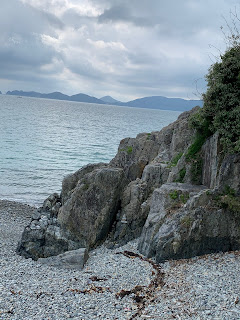After missing out on the azaleas, we tried our luck at finding a large field of irises on Goeje Island. We were a tad bit more successful this trip that last.
Goeje is the second largest island in Korea as is about an hour from Sacheon.
Our quest for irises was a place called Gonggoji Gardens. We stopped in a precious little coffee shop before we started our hike to locate the irises. 



Once we met up with the others we started on up. Gonggoji is nestled back on the mountain and deep in the trees.
 |
| Kate, Chris, Linda, Lotte, Shelley |
This tunnel is created by camellia trees. How stunning it must be when they are in full bloom!




This is the only café in Gonggoji. It was half-way down the hill, buried deep in the woods, with absolutely nothing around it but trees.


A little further down the hill we found Gonggoji Garden.
A husband and wife team transformed their hillside fields into flower gardens over 40 years ago and have been giving it tender loving care since. There are over 50 kinds of plants and flowers growing, including irises, daffodils, camellias, palm trees, and vegetables, to name a few. They sell small bouquets for almost nothing; there is a wooden box to leave your money in if it is unattended when you stop by.


This is the base of one of those palm trees that has been cut.
As you can see, we missed the window of blooms for the irises.
We found some canolas.
There were a few daffodils left.

And there were also a few irises left, but not the vast amount we were hoping to see.

We reached the end of the garden and found Gujora Beach.
This beach did not have sand, but the rocks were a beautiful setting.
I couldn't read this map, but I loved the quaint handmade design.
I also loved the little stone sculptures you find everywhere in Korea.
I always try to capture the intrigue in pictures, but it never comes through.
I wasn't sure if this ramen on the shore was a sea creature or trash. Once I saw several I knew it indeed belonged to the sea.

I looked it up once I got home. It is eggs of sea hares. Sea hares sort of look like slugs on the bottom of the ocean, with two big antennae-like appendages that stick out of their head, much like rabbit ears (hence the name sea hare). These sea hares are hermaphrodites, which is not important but I think is interesting. The ramen-egg ribbons are a result of mating and hold about 80 million eggs!

After stopping for a picnic lunch we continued up the stairs on the Namparang Trail, which led us back to Yegu Village, where we started.
These rocks had little stone sculptures on the different levels, like a curio cabinet. It's unfortunate you can't really see them in the picture.
These rocks had little stone sculptures on the different levels, like a curio cabinet. It's unfortunate you can't really see them in the picture.








































No comments:
Post a Comment